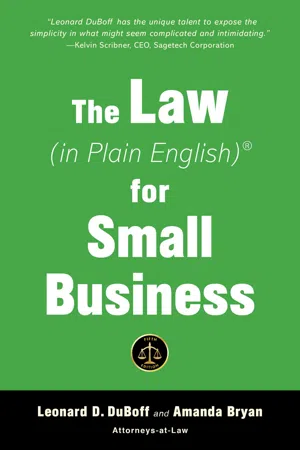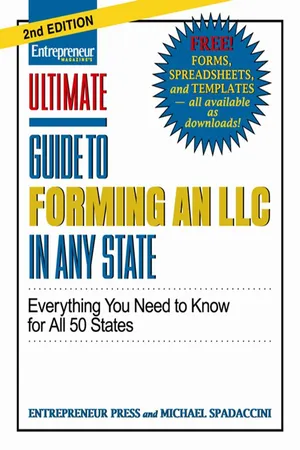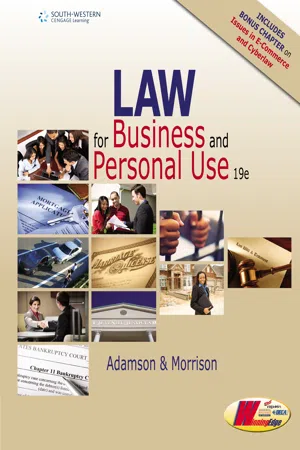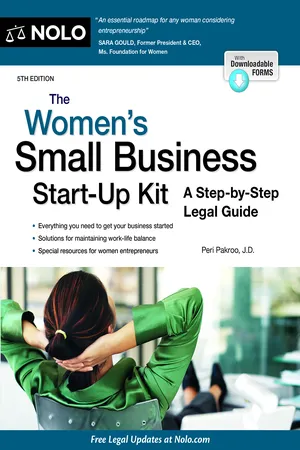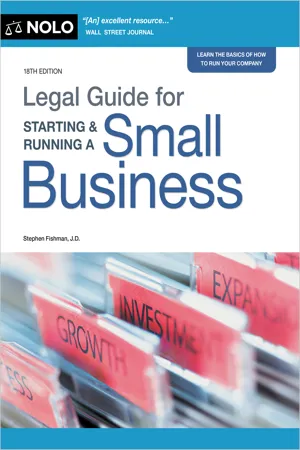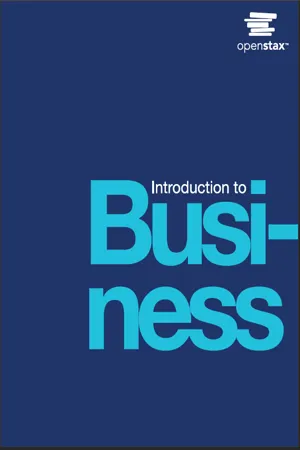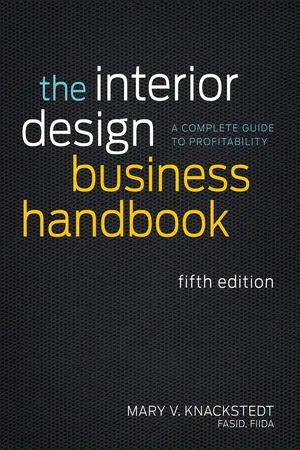Business
Forms of Business
Forms of business refer to the different legal structures through which businesses operate, such as sole proprietorships, partnerships, corporations, and limited liability companies. Each form has its own advantages and disadvantages in terms of liability, taxation, and management structure, allowing entrepreneurs to choose the most suitable option for their specific needs and goals.
Written by Perlego with AI-assistance
Related key terms
1 of 5
12 Key excerpts on "Forms of Business"
- Leonard D. DuBoff, Amanda Bryan(Authors)
- 2019(Publication Date)
- Allworth(Publisher)
CHAPTER 1
Organizing Your Business
Everyone in business knows that survival requires careful financial planning, yet few fully realize the importance of selecting the best legal form for the business. Small businesses have little need for the sophisticated organizational structures utilized in large, publicly traded corporations, but since all entrepreneurs must pay taxes, obtain loans, and expose themselves to potential liability with every sale they make, it only makes sense to structure one’s business so as to address these issues.Every business has an organizational form best suited to it. When we counsel people on organizing their businesses, we usually adopt a two-step approach. First, we discuss various aspects of taxes and liability in order to decide which of the basic legal structures is best. There are only a handful of basic forms—the sole proprietorship, the partnership, the corporation, the limited liability company, the limited liability partnership, and a few hybrids. Once we have decided which of these is most appropriate, we go into the organizational documents such as partnership agreements, corporate bylaws, or operating agreements. These documents define the day-to-day operations of a business and must be tailored to individual situations.What we offer here is an explanation of the features of each of these kinds of organizations, including their advantages and disadvantages. This should give you an idea of which form might be best for your business. We will discuss potential problems, but, since we cannot go into a full discussion of the more intricate details, you should consult an experienced business attorney before deciding to adopt any particular structure. Our purpose is to facilitate your communication with your lawyer and to enable you to better understand the choices available.SOLE PROPRIETORSHIPSThe technical name sole proprietorship may be unfamiliar to you, but chances are you are operating under this form now. The sole proprietorship is an unincorporated business owned by one person. As a form of business, it is elegant in its simplicity. All it requires is a little money and work. Legal requirements are few and simple. Generally, all you need is a business license- eBook - PDF
Ultimate Guide to Forming an LLC In Any State
Everything You Need to Know
- Michael Spadaccini(Author)
- 2010(Publication Date)
- Entrepreneur Press(Publisher)
CHAPTER 1 T he most common Forms of Business enterprises in use in the United States are the sole proprietorship, the general partnership, the limited liability company (LLC), and the corporation. Each form has advantages and disadvantages in complex-ity, ease of setup, cost, liability protection, periodic reporting requirements, operat-ing complexity, and taxation. Also, some business forms have subclasses, such as the C corporation, the S corporation, and the professional corporation. Choosing the right business form requires a delicate bal-ancing of competing considerations. Each of these business forms is briefly discussed in this chapter. THE SOLE PROPRIETORSHIP The sole proprietorship is a popular business form due to its simplicity, ease of setup, and nominal cost. A sole proprietor need only register his or her name and secure local li-censes and the sole proprietorship is ready for business. The sole proprietorship is not a legal entity; it simply refers to a natural per-son who owns the business and is person-ally responsible for its debts. A sole propri-etorship can operate under the name of its owner or it can do business under a fictitious name, such as Nancy’s Nail Salon. The ficti-tious name is simply a trade name—it does not create a legal entity separate from the sole proprietor owner. Fictitious names are covered at length in later chapters. The owner of a sole proprietorship typi-cally signs contracts in his or her own name, because the sole proprietorship has no sep-arate identity under the law. The sole pro-prietor owner will typically have custom-ers write checks in the owner’s name, even if the business uses a fictitious name. Sole proprietorships can bring lawsuits and can be sued using the name of the owner. Many businesses begin as sole proprietorships and graduate to more complex business forms as the business develops. 1 An Overview of Business Organizations - John Adamson, Amanda Morrison(Authors)
- 2016(Publication Date)
- Cengage Learning EMEA(Publisher)
All Rights Reserved. May not be copied, scanned, or duplicated, in whole or in part. Due to electronic rights, some third party content may be suppressed from the eBook and/or eChapter(s). Editorial review has deemed that any suppressed content does not materially affect the overall learning experience. Cengage Learning reserves the right to remove additional content at any time if subsequent rights restrictions require it. 26-1 Main Forms of Business Organization 473 LEGAL VOCABULARY GOALS sole proprietorship, p. 473 partnership, p. 474 corporation, p. 474 ■ State the definitions of the three basic Forms of Business organization ■ Contrast the attributes of the basic Forms of Business organization home, car, and belongings as well as all of his or her business property may be seized to pay the damages awarded by courts. Careful manage-ment, along with adequate liability insurance, can limit these risks and make them acceptable to a small-business person. As a consequence, the sole proprietorship is by far the form of business organization used most often in the United States. Most independent con-tractors listed in the business pages of telephone directories are sole proprietors. There are no significant legal requirements for organizing or conducting most sole propri-etorships. When started, many are conducted out of the owner’s home, garage, or van. No workers need be hired to help the owner, no computer is required for the simple records, and inventory may be limited and often purchased on credit. No charter is needed from the state, although a local business license and perhaps a permit to collect sales taxes for transmittal to the state Principal Business Forms Shirley wants to open a sport-ing goods store catering to women. She hesitates because she thinks the expenses would be prohibitive.- eBook - ePub
Women's Small Business Start-Up Kit, The
A Step-by-Step Legal Guide
- Peri Pakroo(Author)
- 2018(Publication Date)
- NOLO(Publisher)
CHAPTER5
Understanding and Choosing a Legal Structure
Overview of Business Types Sole Proprietorships Pass-Through Taxation Personal Liability for Business Debts Partnerships General vs. Limited Partnerships Pass-Through Taxation Personal Liability for Business Debts Partnership Agreements Limited Liability Companies (LLCs) Limited Personal Liability LLC Taxation Forming an LLC Corporations Limited Personal Liability Corporate Taxation Forming and Running a Corporation Benefit Corporations, L3Cs, and Emerging Business Structures for Socially Conscious, Mission-Driven Businesses Benefit Corporations Certified B Corps Low-Profit Limited Liability Companies (L3Cs) Choosing the Best Legal Structure for Your BusinessChoosing a legal structure for your business is one of the first steps in transforming your idea into an actual, legitimate business. For some, this is a particularly exciting moment. For others, uncertainty about the legal ins and outs of business structures turn this into a stalling point. But take heart: For the vast majority of small to medium-size start-ups, there’s nothing terribly complicated about choosing and setting up the legal structure of the business.In all states, the basic types of business entities are: • sole proprietorships • partnerships (general and limited) • limited liability companies (LLCs), and • corporations (including C and S types).The differences among these types are fairly straightforward and easy to understand. In this chapter, I’ll explain the characteristics, benefits, and drawbacks of each type of business structure, and help you figure out which one is best for your business.TIPYou can change your business structure down the road, - eBook - PDF
- Louis E. Boone, David L. Kurtz, Brahm Canzer(Authors)
- 2021(Publication Date)
- Wiley(Publisher)
Although far fewer firms are organized as corporations, the rev- enues earned by these companies represent over 80% of revenues earned by U.S. businesses each year. Each legal structure offers unique advantages and disadvantages. But because there is no universal formula for every situation, some business owners prefer to organize their 134 CHAPTER 5 Small Business and the Legal Forms of Business Ownership companies further as S corporations, limited-liability partnerships, and limited-liability companies. In some cases, corporations are owned by their employees. In addition to the three main legal structures, several other options for ownership exist. These include employee-owned businesses, family- owned businesses, and not-for-profit organizations. Sole Proprietorships The most common form of business ownership, the sole proprietorship is also the oldest and the simplest. In a sole proprietorship, no legal distinction separates the sole proprietor’s status as an individual from his or her status as a business owner. Although sole proprietorships are common in a variety of industries, they are concentrated primar- ily among small businesses such as repair shops, small retail stores, and service providers such as plumbers, hair stylists, and photog- raphers. The term solopreneur refers to an entrepreneur who works alone, “solo,” and runs his or her business single-handedly without any employees. Sole proprietorships offer some unique advantages. Because such businesses involve a single owner, they are easy to form and dissolve. A sole proprietorship gives the owner maximum management flexibil- ity, along with the right to all profits after payment of business-related bills and taxes. A highly motivated owner of a sole proprietorship directly reaps the benefits of his or her hard work. Minimal legal requirements simplify entering and exiting a sole proprietorship. - eBook - PDF
Accounting
Business Reporting for Decision Making
- Jacqueline Birt, Keryn Chalmers, Suzanne Maloney, Albie Brooks, David Bond, Judy Oliver(Authors)
- 2022(Publication Date)
- Wiley(Publisher)
CHAPTER 3 Business structures LEARNING OBJECTIVES After studying this chapter, you should be able to: 3.1 understand the different forms that business entities take 3.2 defne the term ‘sole trader’ and discuss the main features of a sole trader 3.3 discuss the advantages and disadvantages of a sole trader 3.4 defne the term ‘partnership’ and discuss the main features of a partnership 3.5 discuss the advantages and disadvantages of a partnership 3.6 defne the term ‘company’ 3.7 identify the different types of companies and provide examples of each 3.8 discuss the advantages and disadvantages of a company 3.9 defne the term ‘trust’ 3.10 discuss the advantages and disadvantages of a trust 3.11 compare fnancial statements for different business structures. Pdf_Folio:81 Chapter preview Individuals are regarded as separate business entities from the entities they invest in, trade with and are employed by. This means that, in establishing a business entity, business transactions will be recorded separately from the personal transactions involving the owner(s). This is known as the accounting entity concept and the application of this concept results in the preparation of separate financial statements for the business entity. When an individual establishes a business entity, the choice of the appropriate business structure is an important decision that will have a significant impact on the future direction of the entity. The type of business structure will have implications for such areas as tax, financing the entity, the role of the owners and the extent of liability of the owners. This chapter introduces the different Forms of Business structure. It describes the differences between for-profit entities and not-for-profit entities (NFPs) and the concept of small and medium-sized enterprises (SMEs). It discusses the different focuses of business entities (i.e. manufacturing, trading and service). - eBook - PDF
- Michael Laverty, Colorado State University Global, Chris Littel, North Carolina State University(Authors)
- 2020(Publication Date)
- Openstax(Publisher)
Chapter Outline 13.1 Business Structures: Overview of Legal and Tax Considerations 13.2 Corporations 13.3 Partnerships and Joint Ventures 13.4 Limited Liability Companies 13.5 Sole Proprietorships 13.6 Additional Considerations: Capital Acquisition, Business Domicile, and Technology 13.7 Mitigating and Managing Risks Introduction Entrepreneurial businesses are the heart of the US economy. Small businesses—those with fewer than 500 workers—employ almost one-half of the US workforce (47 percent according to the US Census Bureau’s Annual Survey of Entrepreneurs) [1] and are responsible for offering thousands of new products and services each year. The information in this chapter can help entrepreneurs successfully start and operate a business. Startups function best when the owners have a strong understanding of the legal aspects of entrepreneurship. Important legal issues such as business structure (entity selection), incorporation process, taxation, capital acquisition, and employment policies require that entrepreneurs obtain good advice and make sound decisions before they commence operations. They must make additional decisions that relate to the role of the business in the community, which is a key component of corporate social responsibility. The combination of good advice and sound decisions will help entrepreneurs successfully navigate a complex matrix of considerations. Figure 13.1 Focusing time and energy on planning a business can help an entrepreneur avoid or minimize legal issues. (credit: modification of “hammer books law court lawyer” by “succo”/Pixabay, CC0) 13 Business Structure Options: Legal, Tax, and Risk Issues 1 US Census Bureau. Annual Survey of Entrepreneurs (ASE). 2016. https://www.census.gov/programs-surveys/ase.html - eBook - PDF
The Professional Personal Chef
The Business of Doing Business as a Personal Chef
- Candy Wallace, Greg Forte(Authors)
- 2007(Publication Date)
- Wiley(Publisher)
For more in-depth discussion on forms of ownerships, we recommend to the fol- lowing books: Home-based Business for Dummies, 2 nd Edition, Paul Edwards, Sarah Edwards, and Peter Economy (John Wiley and Sons). Small Business Owners Manual, Joe Kennedy (Career Press, June 2005). True/False 1. Each form of ownership has different tax obligations. 2. A sole proprietorship is similar to a corporation, except for the number of shareholders. 3. A sole proprietorship is the easiest form of business to start. 16 Chapter 2 ■ Forms of Ownership business, but each is liable only to the extent of his or her investment. Joint Venture Partnership Similar to a general partnership except that it exists for a limited period and dissolves at the com- pletion of the project. Partnership Agreement A contract between two or more persons that obligate money, la- bor, and or skills that each offers the business. Also determines the sharing of profits and losses be- tween signing members. Corporation A form of ownership where stock- holders share in the ownership. Stock is sold to shareholders in order to raise capital. Domestic Corporation A U.S. corporation doing business in the state in which it is incorporated. Shareholder A person who holds shares of stock in a company. Dividends The share of profits received by a stockholder from a company. Subchapter S Corporation A form of ownership that enjoys tax advantages beyond those of a corporation. Operating Agreement An agreement among business partners that defines responsi- bilities and management relationships. Limited Liability Corporation (LLC) A form of ownership that limits the liability of the business. It is not permitted in all states. Incorporation Becoming a corporation. Gains The increased value of business or investment. Revenue Total sales during a given period. Gross Receipts The total of all receipts. See Revenue. Inventory The goods and materials in stock; may be referred to as a dollar amount. - eBook - PDF
- Constance E. Bagley, Craig E. Dauchy(Authors)
- 2017(Publication Date)
- Cengage Learning EMEA(Publisher)
CHAPTER 4 Deciding Whether to Incorporate B y carefully considering the Forms of Business entity that are available and then intelligently choosing the most appropriate one, entrepreneurs can reduce exposure to liabilities, minimize taxes, and ensure that the business is capable of being financed and conducted efficiently. In addition, formalizing the business helps prevent misunderstandings among the participants by defin-ing their ownership stakes, roles, and duties in the business. The primary considerations in the choice of business entity will be the degree to which the founders ’ personal assets are pro-tected from liabilities of the business; the availability of favorable tax strategies, such as maximizing the tax benefits of startup losses, avoiding double (or even triple) layers of taxation, and con-verting ordinary income into long-term capital gain, which gener-ally is taxed at lower rates; desirability for potential investors and lenders; availability of attractive equity incentives for employees and other service providers; and costs (startup and ongoing). This chapter first describes each of the principal business forms and then explores the considerations and strategies involved in making an appropriate selection. The governance of each entity is in most instances determined by the domicile of the entity (e.g., in the case of a corporation, the state in which it is incorporated). The most common requirements are set forth below but they can vary from state to state. We conclude with a discussion of name selection and licensing requirements. Struc-tures for international businesses are addressed in Chapter 15. 55 Copyright 2018 Cengage Learning. All Rights Reserved. May not be copied, scanned, or duplicated, in whole or in part. WCN 02-300 - Stephen Fishman(Author)
- 2023(Publication Date)
- NOLO(Publisher)
But sometimes a corporation will be more beneficial. For example, because a corporation—unlike other types of business entities—issues stock certificates to its owners, a corporation can be an ideal vehicle if you want to bring in outside investors or reward loyal employees with stock options. Keep in mind that your initial choice of a business form doesn’t have to be permanent. You can start out as sole proprietorship or partnership and, later, if your business grows or the risks of personal liability increase, you can convert your business to an LLC or a corporation. RELATED TOPIC For some small business owners, a less common type of business structure might be appropriate. While most small businesses will find at least one good choice among the four basic business formats described above, a handful will have special situations in which a different format is required or at least desirable. For example, a pair of dentists looking to limit their personal liability might need to set up a professional corporation or a professional limited liability company. A group of real estate investors could find that a limited partnership is the best vehicle for them. These and other special types of business organizations, including benefit corporations, are summarized at the end of this chapter. SEE AN EXPERT You might need professional advice in choosing the best entity for your business. This chapter gives you a great deal of information to assist you in deciding how to best organize your business. Obviously, however, it’s impossible to cover every relevant nuance of tax and business law—especially if your business has several owners with different and complex tax situations. And for businesses owned by several people who have different personal tax situations, sorting out the effects of “pass-through” taxation (where partners and most LLC members are taxed on their personal tax returns for their share of business profits and losses) is no picnic, even for seasoned tax pros.- eBook - PDF
- Lawrence J. Gitman, Carl McDaniel, Amit Shah, Monique Reece, Linda Koffel, Bethann Talsma, James C. Hyatt(Authors)
- 2018(Publication Date)
- Openstax(Publisher)
It’s so hard to work on those cases, day after day. I needed to see if I would be better somewhere else.” Having enjoyed the rewards of working with the state’s attorney’s office and a corporation and being a sole proprietor, in 2014 MacLean joined a limited liability partnership (LLP, a form of business that you will learn about in this chapter) firm in Chicago. As her needs changed, the form and type of business organization she has worked for has changed also. 130 Chapter 4 Forms of Business Ownership This OpenStax book is available for free at http://cnx.org/content/col25734/1.7 Will you attract employees? How will the business be taxed, and who will be liable for the company’s debts? If you choose to share ownership with others, how much operating control would they want, and what costs would be associated with that? As Table 4.1 illustrates, sole proprietorships are the most popular form of business ownership, accounting for 72 percent of all businesses, compared with 10 percent for partnerships and 18 percent for corporations. Because most sole proprietorships and partnerships remain small, corporations generate approximately 81 percent of total business revenues and 58 percent of total profits. Most start-up businesses select one of these major ownership forms. In the following pages, we will discover the advantages and disadvantages of each form of business ownership and the factors that may make it necessary to change from one form of organization to another as the needs of the business change. As a company expands from small to midsize or larger, the form of business structure selected in the beginning may no longer be appropriate. 4.1 Going It Alone: Sole Proprietorships 1. What are the advantages and disadvantages of the sole proprietorship form of business organization? Jeremy Shepherd was working full-time for an airline when, at the age of 22, he wandered into an exotic pearl market in China, searching for a gift for his girlfriend. - eBook - ePub
The Interior Design Business Handbook
A Complete Guide to Profitability
- Mary V. Knackstedt(Author)
- 2012(Publication Date)
- Wiley(Publisher)
S corporation. This corporation has the limited liability of a corporation, but the profits or losses of the business are passed through to the shareholders and taxed on the individual’s personal tax return. The S corporation itself does not pay any income taxes. There are restrictions and qualifications in order to establish an S corporation, so you should check with your tax advisor and attorney before settling on this form of business.3. Limited liability corporation (LLC). This corporation is similar to an S corporation, in which the shareholders have limited liability protection, and the profits/losses pass through to the shareholders individually. There are a couple of major differences. One is that an S corporation may be formed by one person, but in many states an LLC requires at least two. Also, S corporation profits/losses must be distributed according to each shareholder’s percent of ownership, but those of an LLC may be distributed according to a different plan. Again, you should consult with your tax advisor and attorney to determine the right structure for you.So many factors enter into the tax situation of a sole proprietorship, partnership, or corporation that it cannot be said unequivocally that any one form of business operation is more tax-advantageous than another. You and your accountant must review each situation separately and make projections about each of the various assumptions before deciding which structure is right for you. There are factors other than taxes to be considered in deciding which business structure is advisable for your situation. The tax implications, in fact, may be one of the least important considerations.Some of the other advantages and disadvantages of a corporate form of business as compared with a proprietorship or partnership are as follows. AdvantagesThe principal advantage is that a corporation has limited liability. Shareholders are liable for business debts only to the extent of their investments. There are more perks and fringe benefits available to the shareholder-employee. It is usually easier to transfer ownership. The shareholder needs only to assign stock certificate(s) to the new owner. This also facilitates the settlement of an estate upon the death of a shareholder. The business continues without being interrupted by the transfer of ownership.
Index pages curate the most relevant extracts from our library of academic textbooks. They’ve been created using an in-house natural language model (NLM), each adding context and meaning to key research topics.
